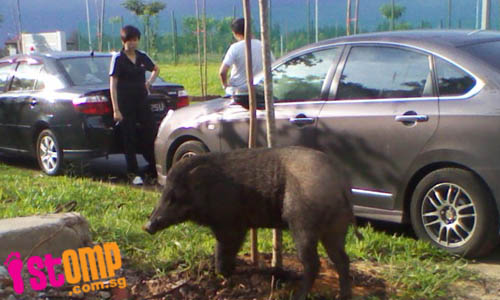
Here is an unusual visitor you do not often meet here in Singapore's concrete jungle. This large wild boar spotted at Punggol Riverside was not just unafraid of humans -- it was practically posing for pictures.
Wild boar are indigenous to this region, and are fairly common in heavily wooded areas, though seldom seen. Because of their shy, retiring nature, it is highly unusual to have one approach humans.
STOMPer Teo wrote:
"Believe it or not.
"I saw a huge wild boar emerging from the Punggol Riverside wetLands last Sunday.
"Hunger may have driven him out from the thick vegetation behind Lorong Halus in search of food from passing cyclists like me.
"He looks relatively tame and came quite close to us, offering me quite a few good shots of him.
"It looks like our efforts to preserve the environment offer a conducive habitats for wild life to survive.
"I would like to share this wonderful sight and discovery!
"Where to locate it -- at the newly opened Punggol Riverside/Promenade along Serangoon River. Cross over by the bridge towards the wetlands."
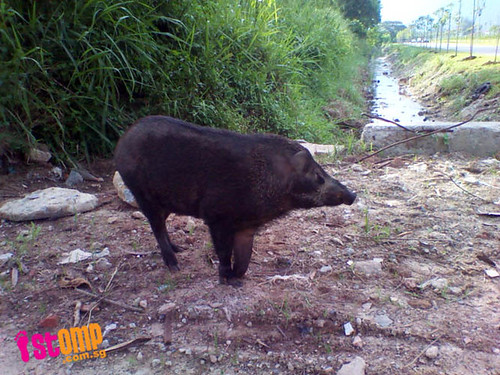
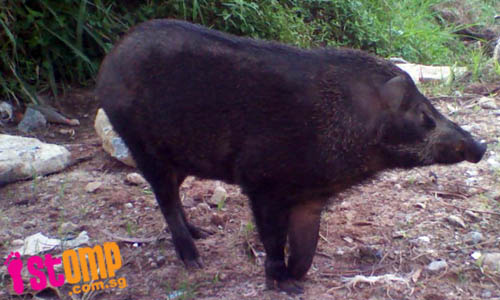
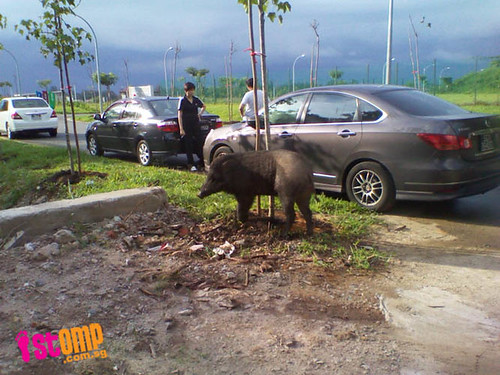

This is a very interesting record of wild boar (Sus scrofa) on mainland Singapore.
It used to be that wild boar were found only on Pulau Ubin and Pulau Tekong, and thought to be extinct on mainland Singapore. Even today, Pulau Ubin still remains the best place to have an encounter with wild boar. I still regret not having had the chance to meet Priscilla or Jack (even though both of them were so tame because they spent time as residents' pets), although it appears that some of the wild boar at Chek Jawa are becoming quite acclimatised to humans.

Priscilla (died 2004);
(Photo by Ria)

Jack (died 2010);
(Photo by hlian)
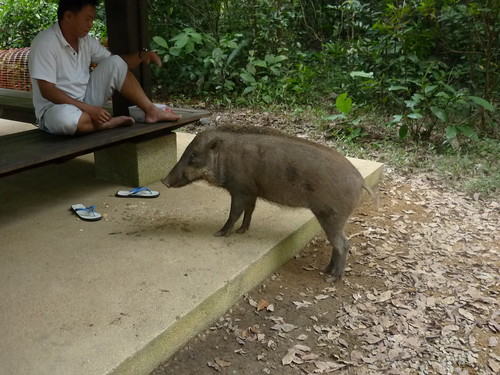
Some of the wild boar at Chek Jawa are now quite tame and approachable;
However, those who have undergone military training in the Western Catchment Area all know that there are wild boar, although it is not known if they have been living there all along, or recolonised the area relatively recently. The wild boar do venture into surrounding areas, and sometimes end up in a bit of trouble; despite it being illegal to catch wildlife, traps are still set for wild boar, and other species do fall victim to these traps.

Nanyang Technological University;
(Photo by adam_zhang)
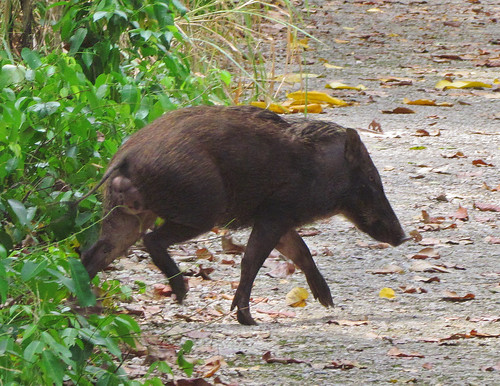
Sungei Buloh;
(Photo by Niki)
Wild boar have also been encountered in Sungei Buloh Wetland Reserve. I would presume that the population there is connected to that living within the Western Catchment Area. The most recent sighting there was just a few days ago.
Wild boar spotted at Sungei Buloh;
(Video by Niki)
Another wild boar stronghold on mainland Singapore is the Central Catchment Nature Reserve, with sightings concentrated at the Nee Soon Swamp Forest and Old Upper Thomson Road-Lower Peirce Reservoir area. A post on STOMP from last November documents an encounter with a herd of wild boar at Upper Peirce Reservoir.

Upper Seletar Reservoir Park;
(Photo by teocmeng)
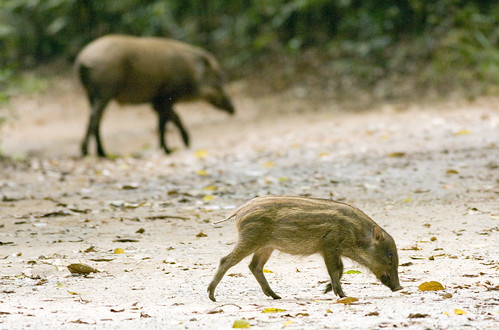
Chek Jawa;
(Photo by Marcus)
In comparison, there are few records from northeast and eastern Singapore. However, it is likely that there are resident wild boar in various areas, due to proximity to Pulau Ubin and Pulau Tekong. 2 of the earliest sightings of wild boar in Singapore hail from Changi, across the sea from Ubin.

Lower Peirce Reservoir Park;
(Photo by Francis Yap)
This paper provides a good summary and discussion of wild boar sightings on mainland Singapore, and also raises the important question as to whether the increasing wild boar population will have negative impacts on the ecology of our forest fragments, in the absence of any significant population control from predators.
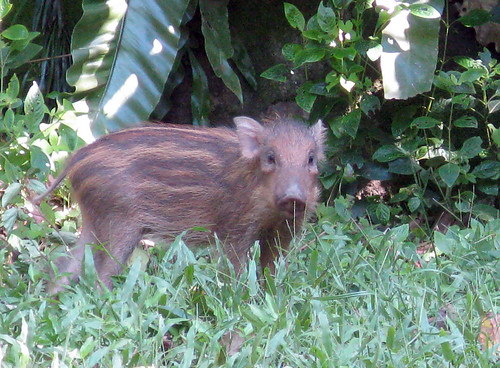
Chek Jawa;
(Photo by Marcus)
According to the details given by the person who submitted this to STOMP, the location appears to be the Lorong Halus Wetland instead, across the river from Punggol Promenade. This individual presents another record from northeast Singapore; there is a sighting from Seletar East Camp in 2008. But this area is not very near the Central or Western Catchment Area, where most of the wild boar are known to live. It is unlikely that a wild boar could have crossed several roads and wandered through some urbanised and densely-populated areas without being detected. So where could this individual have come from?
The Lorong Halus Wetland is situated close to the mouth of Sungei Serangoon, which has been dammed in recent years to form the Serangoon Reservoir. Evidence of wild boar in the form of diggings (made when wild boar forage in the soil with their snouts) have been found on Pulau Serangoon, which is at the mouth of the river. Just across the sea is the island of Pulau Ubin.
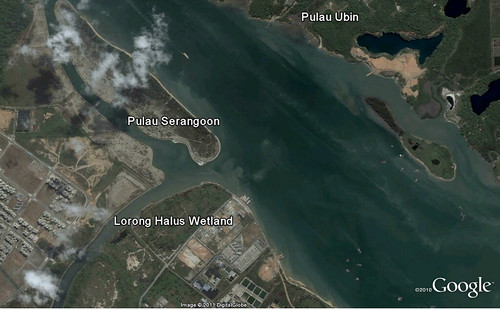
So it's most likely that the wild boar at Lorong Halus (and any other wild boar in the vicinity) swam over from Ubin.
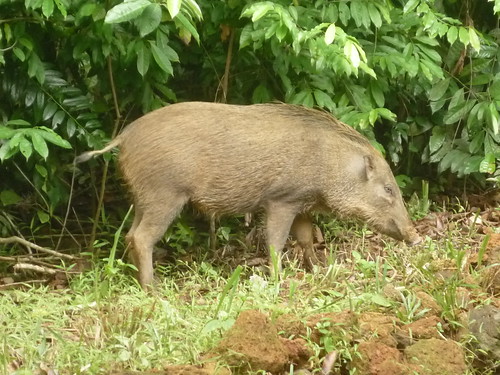
Chek Jawa;
Whether it will become a long-term resident of the park depends a lot on whether it is allowed to stay in the area without disturbance. There is always the possibility that poaching will take place, or that excessive harassment from curious people will encourage it to seek out places with less human traffic.

Sign warning parkgoers about wild boars, Lower Peirce Reservoir Park;
(Photo by Purple_man)
Also, is there enough space for a wild boar at Lorong Halus Wetland? Wild boar can seem tame and endearing (after all, we tamed some of them and now raise their domesticated descendants on farms), but can be dangerous if they feel threatened. It is almost a given fact that people will feed it, or that it has been fed by people in the past, which would account for it actively approaching people. That in itself raises a lot of potential problems; the wild boar may learn to scavenge from rubbish bins, or harass people for handouts. It might even hang out near the car park, putting it at risk of getting hit by a vehicle. Another possible scenario is that the wild boar's wanderings bring it across the bridge to the more urbanised Punggol Promenade area, where it would present a greater hazard to people and property.
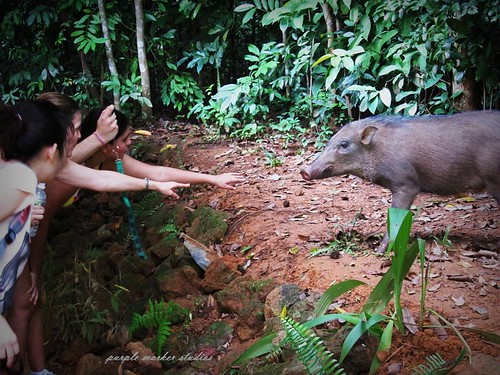
Wild boar can be cute, but is this a disaster waiting to happen? Chek Jawa;
(Photo by purplemarkerstudios)
On one hand, it is a good sign that wild boar are recolonising many parts of mainland Singapore. They are extremely adaptable creatures, and I am sure that some herds will even get used to living in suburban parts of Singapore. In many ways, they symbolise the resilience and adaptability of our local wildlife.
However, at the same time, it is important to take note that potential problems lie ahead, not just in terms of human-wild boar conflict, but also with profound changes to local forest ecology as a result of burgeoning wild boar populations.
For now, I hope that at the very least, the wild boar of Lorong Halus Wetland takes up permanent residence, and that visitors to the park refrain from feeding it. Hopefully, we will learn to accept the presence of wild boar in more of our parks and other green spaces, and learn how to behave appropriately so as to reduce the opportunities for conflict to arise. For all it takes is a single incident of a wild boar charging and injuring a person, no matter how justified, for the uneasy peace to be broken, and to invite even more strident calls to maintain the false separation between man and nature.

Chek Jawa;
(Photo by Marcus)